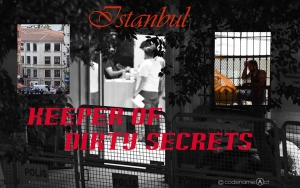
Istanbul — the intoxicating crossroads of east and west; Constantinople, the Golden Horn, Imperial Capital of the Roman, Byzantine, Latin and Ottoman Empires, the only sea route from the Black Sea through the Sea of Marmara to the Mediterranean, strategically placed on the Silk Road; now named a European Capital of Culture – Istanbul, the keeper of dirty secrets.
Most of us become involved in issues when they touch us personally and I am no different. The realities of the current refugee crisis became very real and very personal when my best friend launched himself into the middle of the largest humanitarian crisis since World War II. We both learned a lot and learned it fast. Little did we know how little we really knew until on a stormy summer night here in the US, his attempt to exit the unfriendly streets of Turkey landed him in detention. Irregular exit. Welcome to Kumkapi Removal Center.
Welcome to an intensive short course on the world of Detention, welcome to the unreality of Turkey, a new life of huge organizations known by their initials; EU, UNHCR, ECtHR, IOM and the Turkish legal system where speed means good-by, forced repatriation, no lawyer, no chance to ask UNHCR for asylum, N-O being the operative concept except: Y-E-S to that Iranian Consulate representative despite invoking the right of non-return. Turkish bureaucrats are very hard of hearing.
Life became phone calls, emails, phone calls, internet searches, phone calls, and more emails. Information on Kumkapi was scarce and what I did find was not encouraging. I did have the brochure supplied by Legal aid Lawyers through Caritas, a Catholic NGO, but it was not useful in an emergency. Refugee reality hit home hard for both of us. HOW do you HELP a refugee who is in a foreign land, does not speak the language and is threatened with forcible return, one person in tens of thousands needing the SAME help? What does a refugee DO when they find themselves detained?
Those first days were like a nightmare. I would find an online report about the detention center, for example I discovered the wonderful resource for all things Detention, The Global Detention Project. http://www.globaldetentionproject.org/countries/europe/turkey/introduction.html This website contained a wealth of information, most of it not good. Turkish detention was described as inhumane, unsanitary, and Kumkapi was talked about repeatedly. Then, I would get my phone call from my friend and learn that not only was the report correct, the conditions described in 2012 remained unimproved. It was no longer a dry report online; it had become a reality that had trapped someone I cared about and I did not want to share that everything he was experiencing was KNOWN to the world.
The Kumkapi Removal Center reality, as described by my friend in June 2015, was as follows: “All asylum seekers, including children, are thrown together with criminals such as terrorists and rapists. People have been here for months, without routine exercise, deprived of sunlight. The cells, bathrooms, floors and beds are thick with dirt, allowing diseases such as TB to spread. Pipes are broken, adding even more unsanitary conditions for those detained to cope with. There is not enough bedding for everyone and the lights are never off. Fights are happening and the guards don’t care. Addicts are thrown in and no one helps them. Worst of all, there are children. Instead of providing the detainees with legal aid and giving them the opportunity to ask for asylum, the guards cooperate with the very authorities the detainees are fleeing from. There are 130 to 140 detainees in the men’s section and three guards who only speak Turkish and the detainees are every nationality BUT Turkish. Some days there is not enough food for a three year old.”
That cooperation, referred to by my friend, turned out to be rather frightening as forced meetings with Consular representatives are no joke, nor was that representative’s cavalier statement that everything seen in Kumkapi is purposeful, designed to encourage repatriation, implicit was the threat of forcible return. This was a very real threat even though Turkey is a signatory of the UN 1951 Refugee Convention and a member of the UN which guarantees the right of non-return to asylum seekers. This is a basic human right.
We quickly developed a game plan and I was on a crash course in long distance media entreaty while inside Kumkapi the detention dance was in full swing. The more I looked the more I found. Media was uninterested as anything regarding the Kumkapi Removal Center was old news; no one cared about human rights violations in sight of the fine dining at Kumkapi’s famed Fish Restaurants. I located numerous reports of past European Court of Human Rights cases with Kumkapi figuring large in them and Turkey getting ruled in the wrong. I found the beginnings of what turned out to be the financial underpinning provided by the EU to detain asylum seekers even though the Refugee Convention specifically speaks to this issue and the illegality of detention. I found a few YouTube videos of demonstrations outside an antique building on a leafy side street of Istanbul; a very strange place for a demonstration against illegal detention from my U.S. viewpoint. It was only later I learned that the Kumkapi Removal Center is housed in an antique building over 100 years old right in the heart of the Kumkapi Fish district, a short walk from the Grand Bazaar.
What I could NOT find was a clear avenue on what we should do. No one returned my emails, no one answered phones. The first answer I received was from the International Organization on Migration telling me they were quite sorry they could not help as they did not deal with individual cases. A measure of my desperation was how grateful I was that they replied at all!! The only other answer from the hundreds of emails and phone calls was an invitation for my friend to submit his story and collaborate, by a French NGO, after the August summer holiday. Not a very good return on my hours and hours of work. I did have help from an acquaintance made by my friend a few weeks previously. Her calm willingness to reach out and help another human in need was
emotionally sustaining for us both. Our efforts, listened to on the telephones by the Turkish authorities, coupled with my friend’s determination to not give up, resulted in a connection to media finally occurring. Magically, before media arrived, my friend was released with his asylum application filed with UNHCR.
This is the experience that gave birth to the concept of Codename:Act. The three of us realized that if we could provide information – information in a detainee’s native language – it would enable that person to save themselves from the byzantine games played by the Turkish Polis and Kumkapi staff. If we could enable connections – connections between detainees and lawyers as well as between detainees and the various NGOs already in Istanbul ready to help – this would help friends and family provide assistance. The system in place is designed to hinder communication and facilitate forced repatriation. However, both international and Turkish law provide recourse for asylum seekers. Without knowledge, the asylum seeker is at the mercy of a system designed to send them back to the horror they fled from in the first place. Codename:Act hopes to change this and return the power of self-determination to asylum seekers of all nationalities.

